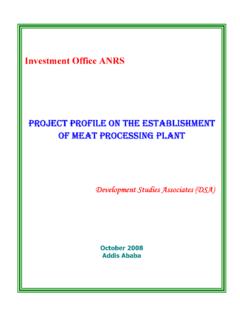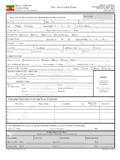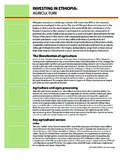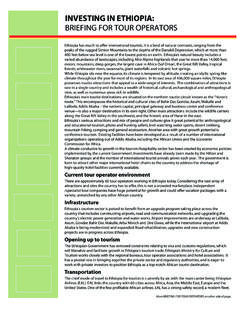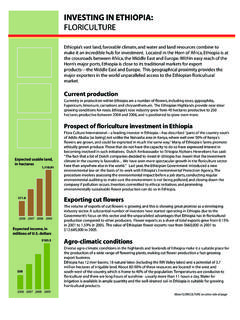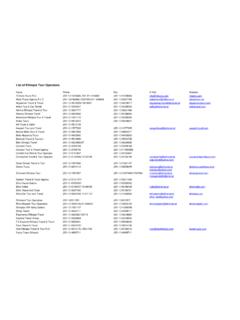Transcription of 100. Poultry Farm - Embassy of Ethiopia
1 100. PROFILE ON Poultry farm 100-2 TABLE OF CONTENTS PAGE I. SUMMARY 100-3 II. farm DESCRIPTION & APPLICATION 100-4 III. MARKET STUDY AND farm CAPACITY 100-4 A. MARKET STUDY 100-4 B. farm CAPACITY & PRODUCTION PROGRAMME 100-8 IV. farm INPUTS AND UTILITIES 100-9 A. farm INPUTS 100-9 B. UTILITIES 100-9 V. TECHNOLOGY & ENGINEERING 100-10 A. TECHNOLOGY 100-10 B. ENGINEERING 100-12 VI. MANPOWER & TRAINING REQUIREMENT 100-16 A. MANPOWER REQUIREMENT 100-16 B. TRAINING REQUIREMENT 100-16 VII. FINANCIAL ANLYSIS 100-18 A. TOTAL INITIAL INVESTMENT COST 100-18 B. PRODUCTION COST 100-19 C. FINANCIAL EVALUATION 100-20 D. ECONOMIC BENEFITS 100-22 100-3 I. SUMMARY This profile envisages the establishment of a farm for the rearing of Poultry with raising capacity of 200,000 heads of Poultry per annum.
2 Poultry meat and eggs have become the most important sources of protein in the human diet by using it directly or after passing through food processing industries. The major inputs and auxiliary raw materials required are day old chickens, commercial formula feed, and high quality vaccines which have to be imported. The present unsatisfied demand for Poultry meat and eggs in Addis Ababa is estimated at 7,750 tonnes and 5,410 tones respectively. The demand is expected to reach at 7,845 tonnes and 11,238 tonnes for eggs and Poultry meat respectively by the year 2020. The total investment requirement is estimated at Birr million, out of which Birr million is required for plant and machinery. The plant will create employment opportunities for 27 persons. The project is financially viable with an internal rate of return (IRR) of % and a net present value (NPV) of Birr million, discounted at %. The Poultry farm has a backward linkage effect on animal feed processing industries and a forward linkage effect on food processing industries.
3 There is also a substantial export potential. 100-4 II. farm DESCRIPTION AND APPLICATION Poultry are large domestic fowl ( hens, ducks, geese, turkey) reared for meat or egg. The consumption of Poultry has increased considerably owing to the speed at which fowl mature and to the small amount of feed required per kg of meat produced. The production cycle for the envisaged Poultry farm starts with day old chicken. Day old chicken is bought for rearing in the envisaged plant by feeding well balanced feed in disease controlled and hygienic shed for about six month and then marketed at this stage. The major consumers of the product of the envisaged plant will be hotels, restaurants, supermarkets, various institutions with food catering services, and households. III. MARKET STUDY AND farm CAPACITY A. MARKET STUDY 1. Past Supply and Current Demand Poultry products such as egg and Poultry meat are the central diets of Ethiopian s.
4 Doro Wet which is prepared from Poultry meat and eggs is one of the favorite dish of the local population which is prepared especially during religious festivals and holidays, virtually in every household in the country. Moreover, eggs as they are easy to prepare and digest, have good test and nutrient are becoming the favored breakfast items in urban areas like Addis Ababa. Accordingly, due to the traditional consumption habit and as the awareness of the population on the nutritional and other advantages of Poultry products increases the market for the products is also expected to expand. Most of the chickens and egg that are supplied to the City Administration s market come from other regional states and, according to the study made by Livestock Marketing Authority in 2004, the number of eggs and chicken that entered the city was estimated to be 56 million, and million, respectively. 100-5 According to the unpublished data of the City Administration s uUrban Agriculture Department (2005), the per capita consumption in Addis Ababa was about kg of eggs and kg of Poultry meat.
5 Accordingly, considering the total population size of Addis Ababa in 2008 the total consumption of the products is give in Table Table TOTAL EGG AND Poultry MEAT CONSUMPTION OF ADDIS ABABA ( 2008 ) Egg consumption per person ( kg) Population size (head) 3,400,000 Total consumption ( Kg) 7,752,000 Poultry meat consumption per person ( kg) Population size (head) 3,400,000 Total Consumption( kg) 8,500,000 As can be seen from Table , the total current consumption of egg and Poultry meat in Addis Ababa is 7,752 tonnes for egg and 8,500 tonnes for Poultry meat. It is estimated that the Poultry population in the Addis Ababa is about 350,000 where most of the chicken are raised on small scale level in the backyards. The Poultry population is insignificant as compared to the national Poultry population, which is estimated at about 63 million. The existing chicken s population in the City are estimated to produce about 2,342 tonnes of egg and 705 tonnes of Poultry meat.
6 The present unsatisfied demand for Poultry meat and eggs in Addis Ababa is estimated at 7,750 tones and 5,410 tonnes, respectively. 100-6 2. Projected Demand The demand for Poultry meat is mainly influenced by population growth and income rise. The 1961, 1967 and 1978 population sample survey for Addis Ababa revealed that the population of Addis Ababa was , and million, respectively. The 1984 census put the population of Addis Ababa at million while the 1994 census recorded 2, people. There is an increase of million or 50 % increase over a decade period. The annual increase over the period 1984-1994 is 5 %. The total population of Addis Ababa in 2007 is estimated to be about The population grows at an average annual growth rate of The city population is estimated to reach million in year 2015. Accordingly, the rapidly increasing population of the city will augment the demand for Poultry products such as egg and Poultry meat.
7 With increasing income or purchasing power, people demand more diversified food products like Poultry products. Therefore, the level of Poultry products consumption has a strong association with the growth of income. One of the indicators that measure the economic performance of a country and the well being of the population is GDP. During the period 1995-2005 real GDP growth averaged a year, export grew by about 5% a year, annual inflation averaged about 4% and in year 2005 investment had risen to 16% of GDP. The positive performance of the Ethiopian economy is expected to continue in the future. As a result, the market for Poultry products may also be expected to increase as economic expansion lead to a raise in the income level of the population. Accordingly, the demand for the products is estimated to grow at per annum which is equivalent to the population growth. Table shows the projected demand for eggs and Poultry meat in Addis Ababa computed by taking the estimated present demand as a base and applying an average annual growth rate of 100-7 Table PROJECTED DEMAND ( IN TONNES) Projected Demand Year Eggs Poultry Meat 2008 5,567 7,975 2009 5,728 8,206 2010 5,894 8,444 2011 6,065 8,689 2012 6,241 8,941 2013 6,422 9,200 2014 6,609 9,467 2015 6,800 9,741 2016 6,997 10,024 2017 7,200 10,315 2018 7,409 10,614 2019 7,624 10,922 2020 7,845 11,238 3.
8 Pricing and Distribution The envisaged farm , as a new entrant into the market, has to penetrate the market and create awareness and product loyalty first. Therefore, the objective of the pricing policy should be to gain a foot hold in the market, get a sizable market share and attempt to sustain a reasonable profitability, which at the initial stage, could only be achieved through charging of lower prices that could influence users of the product. Accordingly, by taking the price of live chicken in to consideration Birr 20 per kg of Poultry meat or 40 per head is proposed for the envisaged plant. 100-8 The product can be sold directly to bulk buyers. For individual buyers existing outlets such as super markets and specialized food items department stores can be used. B. farm CAPACITY AND PRODUCTION PROGRAMME 1. farm Capacity The proposed annual capacity of the Poultry farm by considering the market study and minimum economies of scale is rearing 200,000 heads.
9 The production capacity is determined based on 300 days per year operation of the farm . 2. Production Programme The farm will operate at 70% and 85% of its rated capacity in the first and second year. Full production capacity will be achieved in the third year and then after. Table ANNUAL PRODUCTION PROGRAMME Sr. No. Description Year 1 Year 2 Year 3-10 1 Production (heads). 140,000 170,000 200,000 2 Capacity utilization (%) 70 85 100 IV. farm INPUTS AND UTILTIES A. farm INPUTS The principal farm inputs required are chicken for breeding, Poultry feed, and medicines. Chickens and Poultry feed required by the plant can be acquired locally. The annual 100-9 requirement for farm inputs and the corresponding cost at 100% capacity utilization is given in Table The total annual cost of farm inputs is estimated at Birr 3,740,000. Table ANNUAL REQUIREMENT AND COST ESTIMATES OF farm INPUTS Sr. No. Description Unit of Measure Qty.
10 Unit price Cost ( 000 Birr) 1 Chickens (breed), day old No. 220,000 10 2,200 2 Animal feed Tonnes 720 2000 1,440 3 Medicines Kg 50 2000 100 Grand Total - - 3,740 B. UTILITIES The major utilities required are: water for feeding chickens and general purpose, electric power for lighting and heating. The total yearly consumption of utilities at 100% capacity utilization rate and their estimated costs are given in Table The total annual cost of utilities is estimated at Birr 195,652. Table ANNUAL UTILITIES REQUIREMENT AND ESTIMATED COST Cost Birr Sr. No. Description Unit of Measurement Qty. Unit Cost Total Cost 1 Water m3 50,000 162,500 2 Electric power kWh 70,000 33,152 Grand Total 195,652 100-10 V. TECHNOLOGY AND ENGINEERING A. TECHNOLOGY 1. Production Process Chicken production is typically carried out at so-called complexes. Each complex contains a feed mill, a hatchery, a processing plant, and chicken farms where the chicks are raised, usually in a 30-40 mi ( km) radius from the processing plant.


